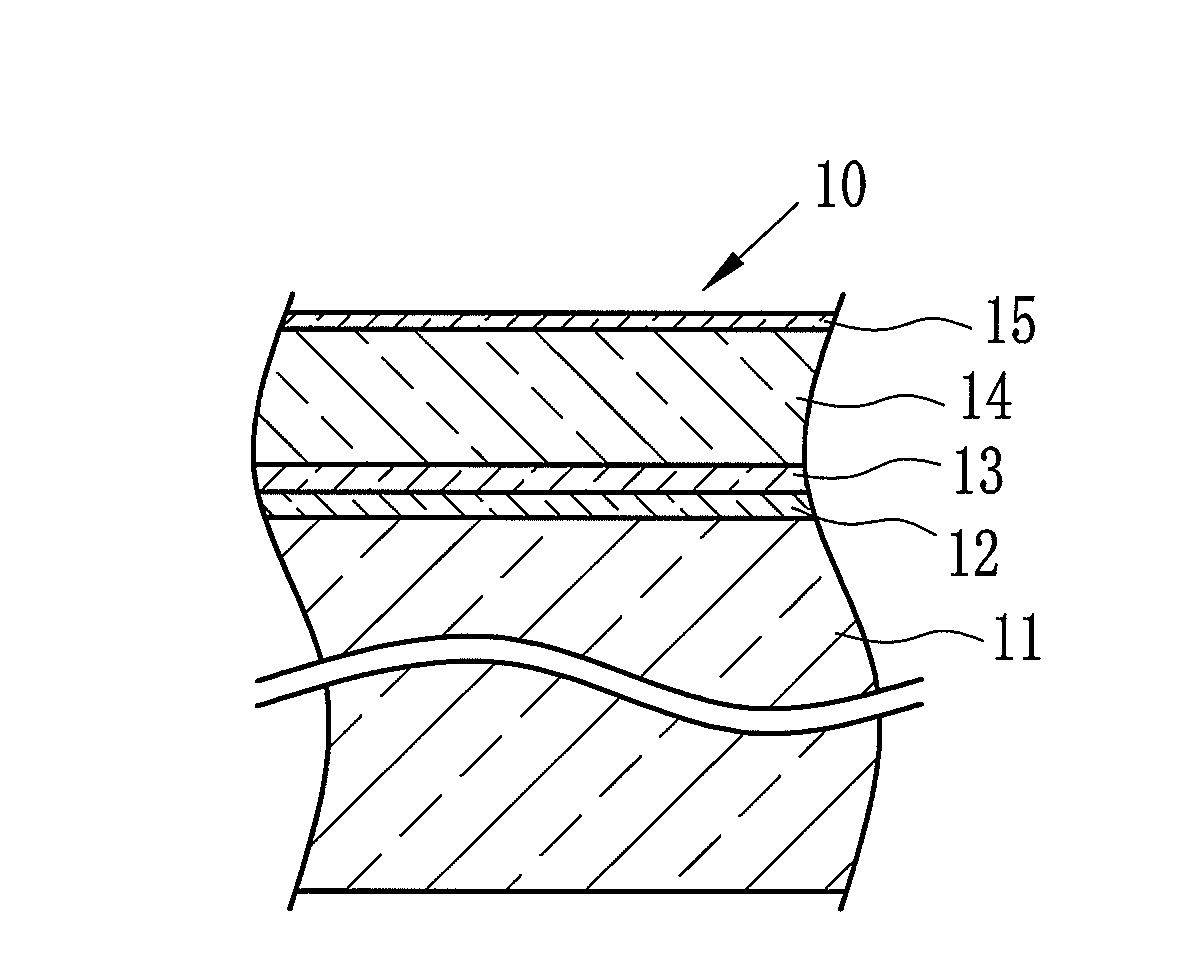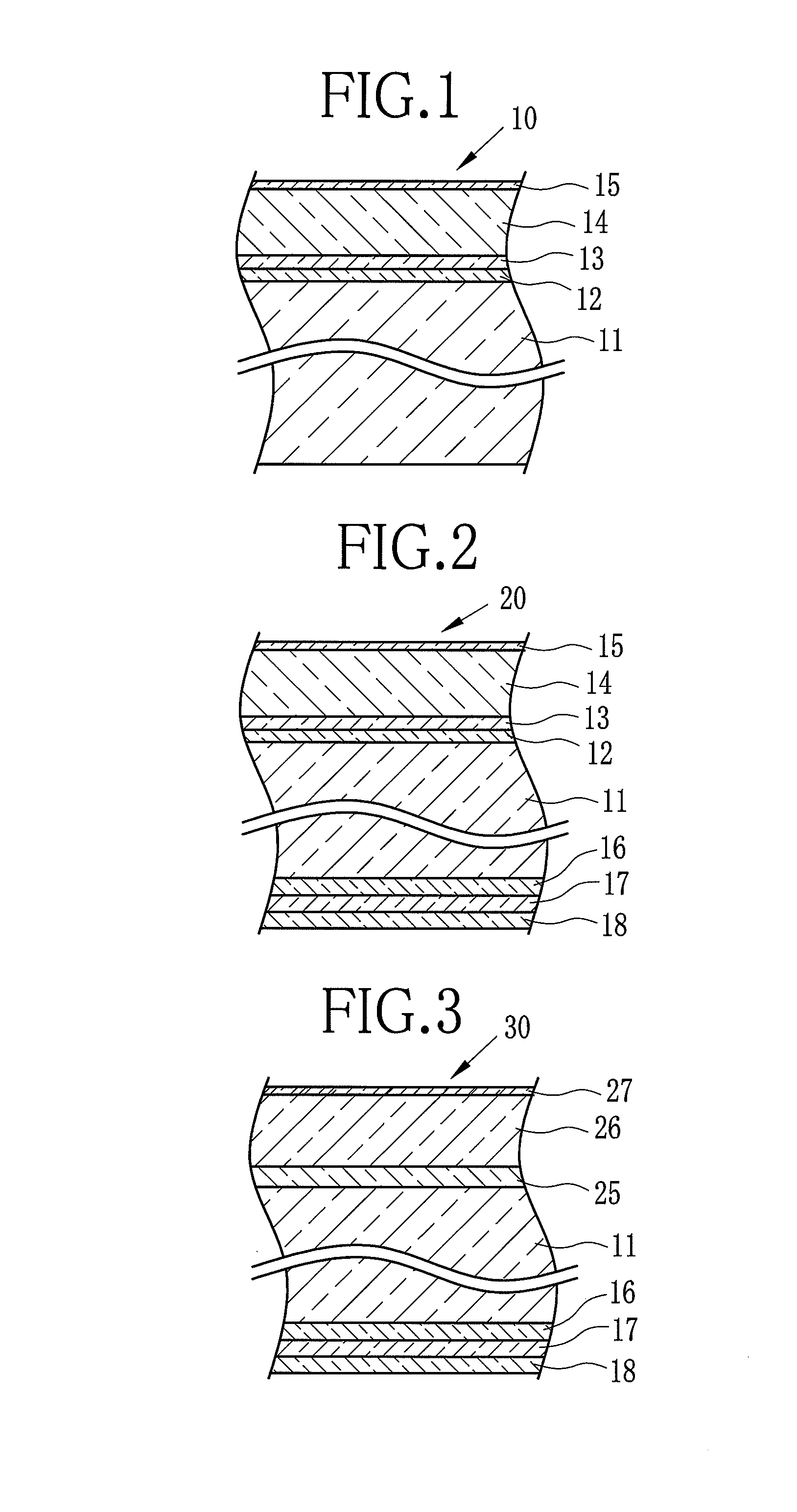Optical multilayer film and image display device
- Summary
- Abstract
- Description
- Claims
- Application Information
AI Technical Summary
Benefits of technology
Problems solved by technology
Method used
Image
Examples
example 1
[0080]In this example, in accordance with the following procedure, the multilayer film shown in FIG. 1 was formed.
[0081][Base Material]
[0082]Polyethylene terephthalate (hereinafter referred to as PET) having inherent viscosity of 0.66 was synthesized by polycondensation reaction. The catalyst used in the reaction was antimony trioxide. The PET was dried until the water content thereof became 50 ppm or less, and thereafter melted in an extruder having a heater set at the temperature of 280 to 300° C. Next, the melted PET was discharged onto a chill roll to which electrostatic charge was applied from a die section, thus obtaining an amorphous film. Subsequently, the amorphous film was stretched by 2.9 times in the longitudinal direction of the film, and further stretched by 4.0 times in the width direction thereof, thus completing the biaxially stretching and producing the base material 11 having the thickness of 150 μm. Note that the refractive index η1 of the base material 11 thus o...
example 2
[0098]As shown in Table 1, experiment was performed in the same manner as Example 1 except that the coating liquid A in Example 1 was substituted by a coating liquid C and the coating liquid B in Example 1 was substituted by a coating liquid D in Example 2.
[0099][Coating Liquid C]
[0100]Each of the materials whose application amount of solid content is as follows is mixed together to prepare the coating liquid C.
Polyurethane52.0 (mg / m2) Carbodiimide compound10.4 (mg / m2) Surfactant A0.5 (mg / m2)Surfactant B1.0 (mg / m2)Tin oxide dispersion liquid110.0 (mg / m2)
[0101][Coating Liquid D]
[0102]Each of the materials whose application amount of solid content is as follows is mixed together to prepare the coating liquid D.
Polyurethane47.0 (mg / m2) Carbodiimide compound9.4 (mg / m2)Surfactant A0.5 (mg / m2)Surfactant B1.0 (mg / m2)Titanium oxide dispersion liquid (Dispersion66.0 (mg / m2) liquid in which titanium oxide fine particleare dispersed in water)Silica dispersion liquid1.2 (mg / m2)Carnauba wax3.0 ...
example 3
[0103]As shown in Table 1, experiment was performed in the same manner as Example 1 except that the coating liquid A in Example 1 was substituted by a coating liquid E and the coating liquid B in Example 1 was substituted by a coating liquid F in Example 3.
[0104][Coating Liquid E]
[0105]Each of the materials whose application amount of solid content is as follows is mixed together to prepare the coating liquid E.
Acrylic resin73.0 (mg / m2)Carbodiimide compound14.6 (mg / m2)Surfactant A 0.5 (mg / m2)Surfactant B 1.0 (mg / m2)Tin oxide dispersion liquid14.0 (mg / m2)
[0106][Coating Liquid F]
[0107]Each of the materials whose application amount of solid content is as follows is mixed together to prepare the coating liquid F.
Polyester58.0 (mg / m2)Carbodiimide compound11.6 (mg / m2)Surfactant A 0.5 (mg / m2)Surfactant B 1.0 (mg / m2)Tin oxide dispersion liquid56.0 (mg / m2)Silica dispersion liquid 1.2 (mg / m2)Carnauba wax 3.0 (mg / m2)
PUM
 Login to View More
Login to View More Abstract
Description
Claims
Application Information
 Login to View More
Login to View More - R&D
- Intellectual Property
- Life Sciences
- Materials
- Tech Scout
- Unparalleled Data Quality
- Higher Quality Content
- 60% Fewer Hallucinations
Browse by: Latest US Patents, China's latest patents, Technical Efficacy Thesaurus, Application Domain, Technology Topic, Popular Technical Reports.
© 2025 PatSnap. All rights reserved.Legal|Privacy policy|Modern Slavery Act Transparency Statement|Sitemap|About US| Contact US: help@patsnap.com


